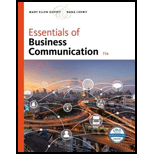
Essentials of Business Communication (MindTap Course List)
11th Edition
ISBN: 9781337386494
Author: Mary Ellen Guffey, Dana Loewy
Publisher: Cengage Learning
expand_more
expand_more
format_list_bulleted
Concept explainers
Question
Chapter 1, Problem 1.12AAC
Summary Introduction
To determine:-
The meaning of certain selected gestures that have different meanings in different countries.
Introduction:-
Gestures are a part of nonverbal cues that help a communicator to send his message to the listener. But one must be cautious while doing so if he is in a country other than his as in certain cases different countries have different meanings for the same gestures.
Expert Solution & Answer
Trending nowThis is a popular solution!

Students have asked these similar questions
Company Y reported FIFO ending inventory of $126,500 and a beginning inventory of $119,200 for 2021. Inventory purchases for 2021 were $265,300, and the change in the LIFO reserve for 2020 was an increase in the LIFO reserve of $890. Calculate the value of COGS LIFO for Company Y in 2021.
The cost formula for the maintenance department of Redwood Manufacturing is $18,500 per month plus $7.25 per machine hour used by the production department. Calculate the maintenance cost that would be budgeted for a month in which 5,400 machine hours are planned to be used.
general accounting
Chapter 1 Solutions
Essentials of Business Communication (MindTap Course List)
Knowledge Booster
Learn more about
Need a deep-dive on the concept behind this application? Look no further. Learn more about this topic, subject and related others by exploring similar questions and additional content below.Similar questions
- I need help solving this general accounting question with the proper methodology.arrow_forwardA previously completed Job Q had $12,500 in direct labor with $8,750 in overhead costs.arrow_forwardProblem 2: The sales data over the last 10 years for the Acme Hardware Store are as follows: 2003 $230,000 2008 $526,000 2004 276,000 2009 605,000 2005 328,000 2010 690,000 2006 388,000 2011 779,000 2007 453,000 2012 873,000 1. Calculate the compound growth rate for the period of 2003 to 2012. 2. Based on your answer to part a, forecast sales for both 2013 and 2014. 3. Now calculate the compound growth rate for the period of 2007 to 2012. 1. Based on your answer to part e, forecast sales for both 2013 and 2014. 5. What is the major reason for the differences in your answers to parts b and d? If you were to make your own projections, what would you forecast? (Drawing a graph is very helpful.)arrow_forward
- Can you help me solve this general accounting problem using the correct accounting process?arrow_forwardV Industries has sales of $240,000 and the cost of goods available for sale of $198,000. If the gross profit rate is 32.75%, the estimated cost of the ending inventory under the gross profit method is? Help mearrow_forwardExercise 4A firm has the following average cost: AC = 200 + 2Q – 36 Q Find the stationary point and determine if it is a maximum or a minimum.b. Find the marginal cost function.arrow_forward
arrow_back_ios
SEE MORE QUESTIONS
arrow_forward_ios
Recommended textbooks for you
 Management, Loose-Leaf VersionManagementISBN:9781305969308Author:Richard L. DaftPublisher:South-Western College Pub
Management, Loose-Leaf VersionManagementISBN:9781305969308Author:Richard L. DaftPublisher:South-Western College Pub Understanding Management (MindTap Course List)ManagementISBN:9781305502215Author:Richard L. Daft, Dorothy MarcicPublisher:Cengage Learning
Understanding Management (MindTap Course List)ManagementISBN:9781305502215Author:Richard L. Daft, Dorothy MarcicPublisher:Cengage Learning


Management, Loose-Leaf Version
Management
ISBN:9781305969308
Author:Richard L. Daft
Publisher:South-Western College Pub

Understanding Management (MindTap Course List)
Management
ISBN:9781305502215
Author:Richard L. Daft, Dorothy Marcic
Publisher:Cengage Learning